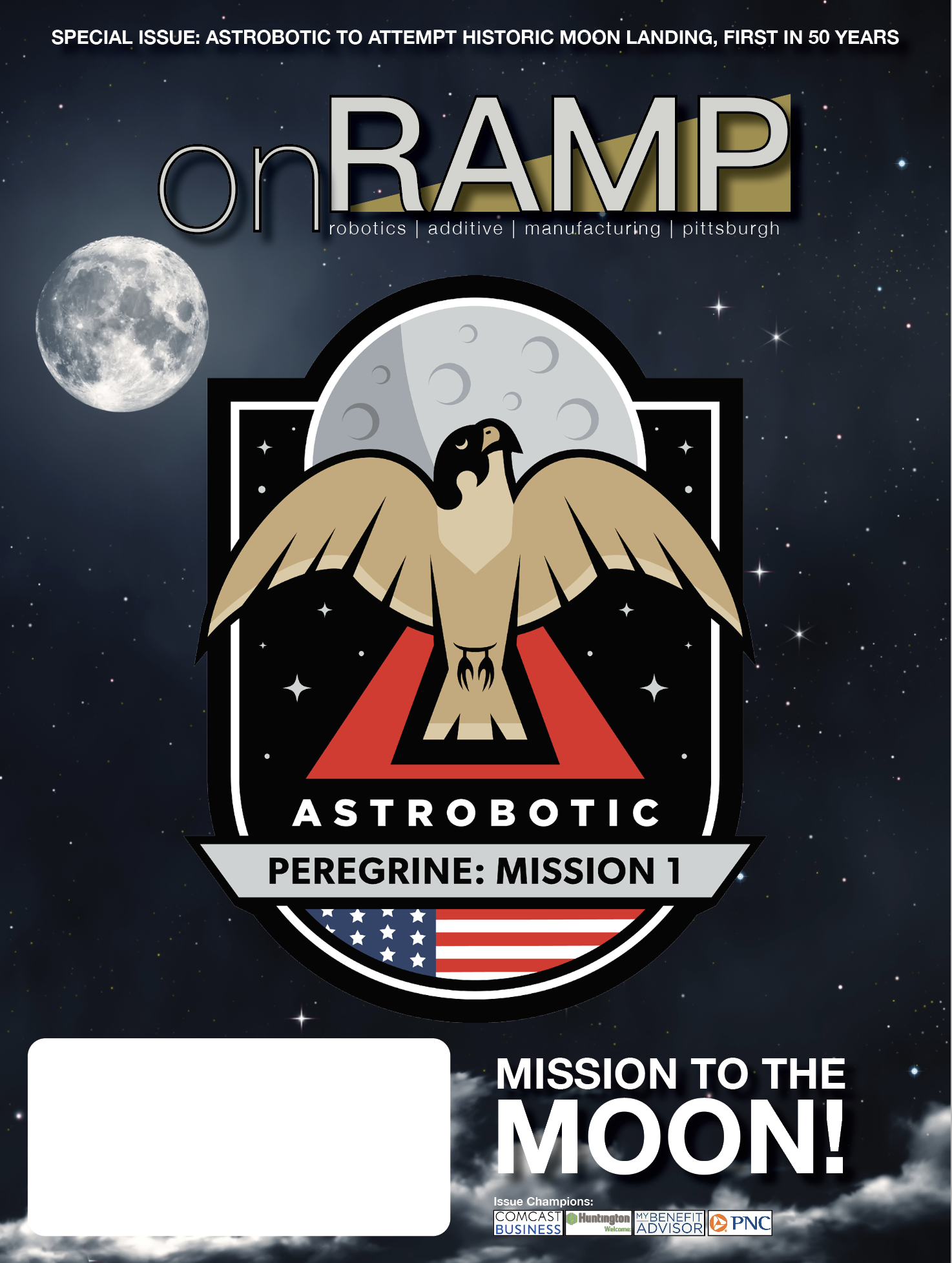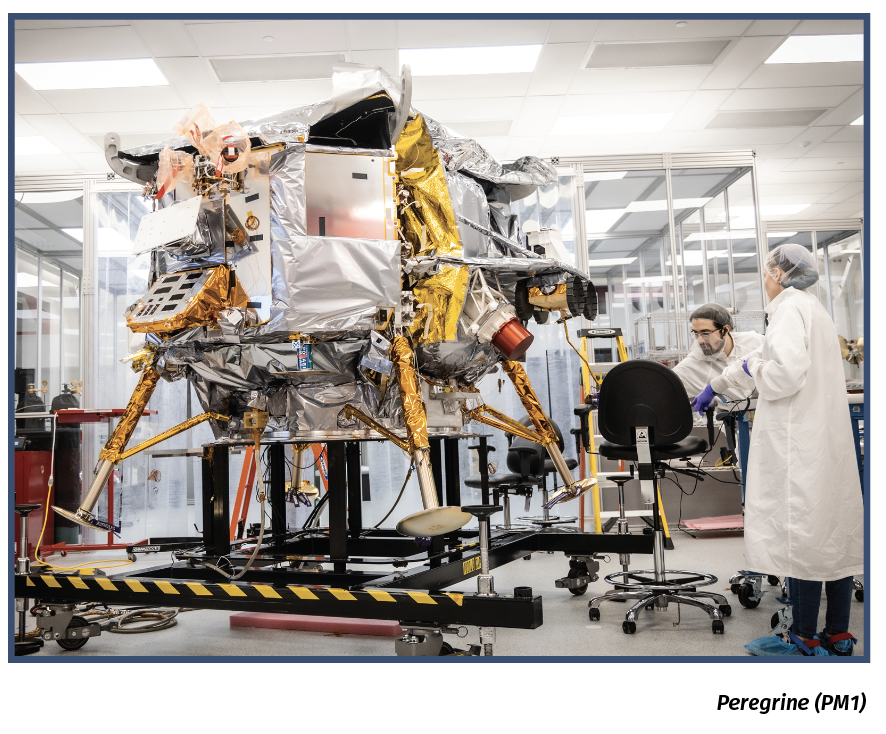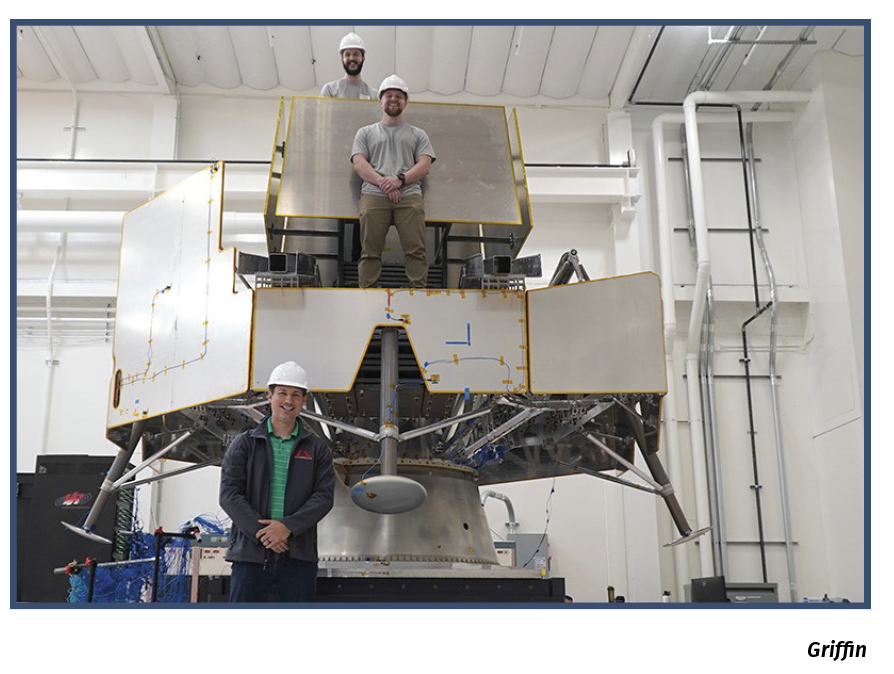Mission to the Moon! Astrobotic to Attempt Moon Landing
By Sheena Carroll, Pittsburgh Technology Council
 In 1866, Atlantic Monthly writer James Parton described visiting Pittsburgh as “like looking over into hell with the lid taken off.” For decades, the Steel City doubled as the Smoky City, with dense air pollution blocking the view above. In recent years the air has cleared, and Pittsburghers have been able to better enjoy the night sky. And now, Pittsburgh will be exploring that sky, thanks to Astrobotic’s execution of what will be both the first commercial mission to the Moon and the first American lunar lander to soft land there since Apollo 17. That isn’t to say that Pittsburgh has never had a presence in space, but Astrobotic’s Peregrine Mission One (PM1) is the newest and possibly the most ambitious of these projects – and its launch is scheduled for 2023!
In 1866, Atlantic Monthly writer James Parton described visiting Pittsburgh as “like looking over into hell with the lid taken off.” For decades, the Steel City doubled as the Smoky City, with dense air pollution blocking the view above. In recent years the air has cleared, and Pittsburghers have been able to better enjoy the night sky. And now, Pittsburgh will be exploring that sky, thanks to Astrobotic’s execution of what will be both the first commercial mission to the Moon and the first American lunar lander to soft land there since Apollo 17. That isn’t to say that Pittsburgh has never had a presence in space, but Astrobotic’s Peregrine Mission One (PM1) is the newest and possibly the most ambitious of these projects – and its launch is scheduled for 2023!
Pittsburgh’s first step toward landing on the Moon started in a 400- square-foot room above a bagel shop in Oakland. A private company spinoff from Carnegie Mellon University’s Robotics Institute in 2007, Astrobotic has grown rapidly in recent years. The company has signed fifteen commercial customers representing six countries for its lunar payload delivery service and won a $79.5 million NASA contract to fly scientific instruments aboard their own lunar lander, Peregrine. In 2020, Astrobotic also won a $199.5 million contract to deliver NASA’s water-hunting rover, VIPER, to the South Pole of the Moon.
Now nestled in an unassuming alcove in the North Side behind a McDonald’s and a Wendy’s, Astrobotic’s current 47,000-square-foot complex is the largest private facility in the world dedicated to lunar logistics. The company uses the facility to build and operate its lines of landers, rovers, autonomous spacecraft navigation systems, and other space tech. When Peregrine lands on the Moon, it will be controlled directly from the Astrobotic Mission Control Center inside these headquarters.
Astrobotic is composed of five departments – Landers & Spacecraft, Lunar Surface Systems, Space Robotics, Propulsion & Test, and Business Development. The departments are made up of a growing team of 200, with more than 600 years of combined experience in the space industry. Many of these experts call Pittsburgh their hometown.
“It's going to be a historic, momentous event for our nation and for Pittsburgh,” Thornton said. “If Pittsburgh can land on the Moon, Pittsburgh can do anything.”
“The team behind Peregrine has been recruited and brought in from all over the country. They are alum from some of the largest aerospace companies in the nation. But I think probably one of the interesting things about our folks is there's a fair number of Pittsburgh ‘boomerangers,’” said John Thornton, Astrobotic CEO.
“They are Pittsburghers who went off to do space work because they love it but couldn't do that here in Pittsburgh. And now with Astrobotic, they were able to move back and be near their family and friends and be where they grew up in their hometown, and work in space there – their true passion and love.”
Peregrine
 The Peregrine lunar lander is a spacecraft that operates with its own electronics, propulsion, and communications systems to deliver cargo to the Moon. Peregrine Mission One will be carrying payloads from 14 customers, including many payloads from the NASA CLPS program. The PM1 manifest includes seven countries represented in the form of companies, governments (NASA, AEM and DLR space agencies), universities, non-profits and individuals from the U.S., U.K., Germany, Japan, Mexico, Seychelles and Hungary. Through Astrobotic’s DHL MoonBox programs, there are also thousands of individuals who are sending mementos, photos, time capsules, art and more to the Moon.
The Peregrine lunar lander is a spacecraft that operates with its own electronics, propulsion, and communications systems to deliver cargo to the Moon. Peregrine Mission One will be carrying payloads from 14 customers, including many payloads from the NASA CLPS program. The PM1 manifest includes seven countries represented in the form of companies, governments (NASA, AEM and DLR space agencies), universities, non-profits and individuals from the U.S., U.K., Germany, Japan, Mexico, Seychelles and Hungary. Through Astrobotic’s DHL MoonBox programs, there are also thousands of individuals who are sending mementos, photos, time capsules, art and more to the Moon.
Peregrine will launch on a United Launch Alliance (ULA) Vulcan Centaur rocket from Cape Canaveral at Launch Complex 41.
There’s a meaning behind the lander’s name: the peregrine falcon is the most widely distributed bird of prey, with a presence on every continent (minus Antarctica). Countless people and cultures from around the world are represented on Astrobotic’s Peregrine lander. Peregrines are also nimble and quick, clocking in at over 200 mph and earning the title as fastest animal on the planet!
“Our Peregrine lander is aptly named to represent how Astrobotic has nimbly adapted to the many challenges and changing landscapes of the space sector,” said Thornton. “This design tells our PM1 story every time it’s sewn onto a jacket or projected onto a screen.”
Griffin
 The largest lunar lander since Apollo’s LM (lunar module), Griffin will deliver NASA’s one-ton Volatiles Investigating Polar Exploration Rover (VIPER) to the Moon. It will land at the South Pole and deploy VIPER to conduct the first widespread ground truth measurements of lunar water ice. Such ice may one day be used for life support and propellant that could assist future deep space explorers.
The largest lunar lander since Apollo’s LM (lunar module), Griffin will deliver NASA’s one-ton Volatiles Investigating Polar Exploration Rover (VIPER) to the Moon. It will land at the South Pole and deploy VIPER to conduct the first widespread ground truth measurements of lunar water ice. Such ice may one day be used for life support and propellant that could assist future deep space explorers.
Some of the instruments on PM1 will be operated as a dress rehearsal for their use on VIPER. This contract was awarded under the NASA CLPS program.
Griffin’s testing included attempting many complex landing configurations, including ramps angled to 33 degrees — comparable to many of the steepest roads in Pittsburgh!
Why the Moon?
The Moon is a logical destination for an early landing mission, largely due to its proximity to Earth. Relatively speaking, it is really close to us.
“The Moon is only a little less than a quarter million miles away from Earth,” Thornton explained. “When you think about the odometer on your car — my car has 170,000 miles on it — a quarter million miles is not that far. If you were driving your car at highway speeds and going to the Moon, it would take you about six months to get there. It would take 86 years to get to Mars at highway speeds.”
This makes the Moon an ideal location for learning to live on another planetary body and how to extract resources from another planetary body. It's also the place to learn more about how Earth itself works, and eventually to craft the building blocks to use the resources of space for Earth’s purposes.
The Moon is for Earth’s benefit?
 Thornton sees the Moon as the gateway to our solar system and where we will learn how to become a species beyond Earth. He imagines the day that we're able to protect our delicate planet – no more drilling or mining or polluting our lakes, streams and oceans. This could be accomplished if resources that we need to live and grow on our planet are coming from space. The number of resources in space are truly limitless.
Thornton sees the Moon as the gateway to our solar system and where we will learn how to become a species beyond Earth. He imagines the day that we're able to protect our delicate planet – no more drilling or mining or polluting our lakes, streams and oceans. This could be accomplished if resources that we need to live and grow on our planet are coming from space. The number of resources in space are truly limitless.
“There's a rock, for example, orbiting our Sun today – not even a planet, just an asteroid – that has more metal in it than mankind has ever mined, worth trillions and trillions of dollars. It’s remarkable to think about that. Just imagine what that would do to society if resources like that can truly be limitless. That’s what space offers.”
Of course, this level of development would occur far into the future, but the space industry is staging the building blocks for it now.
Going to the Moon is difficult – but why?
There are many reasons why the United States hasn’t visited the Moon since Apollo, and they can mostly be summed up with three words: Space. Is. Hard.
Any spacecraft headed to the Moon is faced with extreme conditions: extreme cold, extreme heat and extreme radiation. Daytime temperatures on the Moon reach well over water’s boiling point at an average of 250 degrees Fahrenheit (120 degrees Celsius). Meanwhile, the two-week-long lunar nights reach temperatures as low as -208 degrees Fahrenheit (-130 degrees Celsius). This massive temperature swing is exacerbated by the amount of the Sun’s radiation that the Moon receives. Unlike Earth, the Moon has no electromagnetic sphere that can deflect radiation (or, for that matter, burn away any micrometeorites that could potentially damage the craft).
Lunar nights are of especially great concern. Thornton explained, “A lot of programs, including ours, will be unlikely to survive the night — at least the early missions. But we do have plans and developments for future planning missions that can survive at night and operate for days or years on the surface the Moon.”
There is also the vacuum of space, which Thornton describes as exceedingly difficult for designers to tackle. Hazard detection is also incredibly difficult, as the combined conditions of space and the significant distance between the Moon and Earth make remote control near impossible. There is no GPS on the Moon!
Thornton said, “If we are successful, it truly is the dawn of a new era for lunar exploration and the possibilities of what we could bring into the future.”
“When you're flying out to the Moon, there's a time delay in your communications,” explained Thornton. “So, if you sent a ping back to Earth and then waited for it to come back, it can be anywhere between three and 30 seconds for that communication to make a round trip, because of ground network delays.”
Developing landing tech is another challenge. In space, there is no “up” or “down.” For any craft, space travel is like being stuck in an avalanche or underwater. So how can Astrobotic ensure that Peregrine and Griffin will land properly onto the surface? Once a craft reaches the surface, it needs a system that can absorb the impact of landing and not bounce back. To solve this, Astrobotic has built its landers with legs that are designed to crush. Inside of the legs is a crushable honeycomb that will not bounce back.
 Peregrine will then use its own fuel and propulsion system to guide it through space. During landing operations, a Doppler LiDAR (think, a laser equivalent to bat sonar) provides range and range rate information that guides the lander to a safe landing at the target site. It utilizes cameras, LiDAR [scanning lasers], and Astrobotic software to build an accurate, 3D map of an area in real time. Think of it like a bat using sound to ‘see,’ but with light,”
Peregrine will then use its own fuel and propulsion system to guide it through space. During landing operations, a Doppler LiDAR (think, a laser equivalent to bat sonar) provides range and range rate information that guides the lander to a safe landing at the target site. It utilizes cameras, LiDAR [scanning lasers], and Astrobotic software to build an accurate, 3D map of an area in real time. Think of it like a bat using sound to ‘see,’ but with light,”
But perhaps the greatest challenge of Moon exploration is the overwhelming presence of regolith, or Moon Dust. Regolith is jagged and can obscure and damage instruments like solar panels. The dust can get into mechanisms and cause problems there can interfere with solar arrays and with radiators, potentially resulting in overheating.
“It's small and seemingly insignificant,” Thornton said. “But the dust on the Moon is very different than dust here on Earth. Dust on the Moon was created by impacts on the Moon. It's basically like shards of broken glass. And it's almost like Velcro on a microscopic level. Regolith sticks to everything. And it's electrostatically charged. So, it's like that dust you just can't get off your lens.”
Regolith was a major struggle for the Apollo astronauts, who quickly found their white suits covered in the dark dust, which made them less efficient at cooling. The astronauts landed on the surface in the morning and left by mid-morning before the heat became too much. They described the dust as smelling like spent gunpowder, and many reported irritations in their lungs.
These factors combined are why traveling to and exploring the Moon is so challenging. This is why, historically, only nations considered superpowers have done it before. But now, Astrobotic is trying to break that mold and make it possible for routine, regular and affordable flights to the surface of the Moon. Their first mission is poised to reach the Moon for around $100 million, a tiny fraction of what it would traditionally cost to fly and land such a mission.
About this, Thornton said, “If we are successful, it truly is the dawn of a new era for lunar exploration and the possibilities of what we could bring into the future.”
“The problems that we're going to face are quite challenging, but they are achievable. They are things that we can overcome. We have the technology; we just need to figure out how to smartly put it all together and make it sustainable.”
As of the writing of this article, Peregrine has arrived in Cape Canaveral after completing its final tests in Pittsburgh. Launch day is drawing near and the reality of it all is as close as it has ever been before.
“It's going to be a historic, momentous event for our nation and for Pittsburgh,” Thornton said. “If Pittsburgh can land on the Moon, Pittsburgh can do anything.”